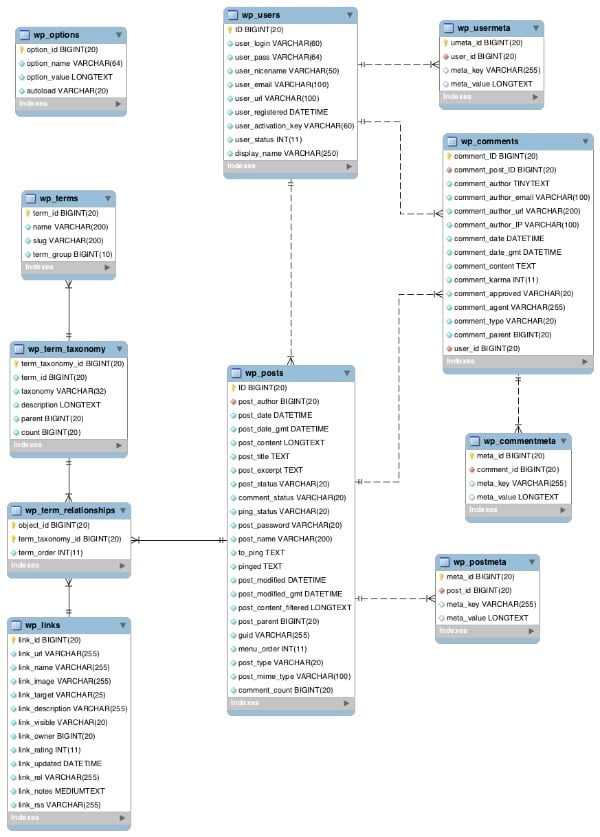
A WordPress website consists of three main elements:
wp-content Contents of the directory, including themes, plugins and uploaded contentMost WordPress users have never directly touched a database and may not even be aware that it is constantly populating their website. When WordPress serves any type of page, whether it’s a home page, a single post or page, or an archive, it accesses the database to display the content that editors and administrators have added to the site.
In this series of tutorials, I will detail different aspects of the WordPress database. The series will be divided into nine parts and will cover the following:
In this introduction, I will provide an overview of database tables and how they relate to the content types you may be used to working with in WordPress, and identify where to store content.
Since database tables are used to store content, you need to understand the content before understanding them. There are many types of content in WordPress:
These content types have data attached:
In addition to this, there are other types of content that are stored in different ways:
All of these types of content are stored somewhere in the database (or occasionally in a theme or plugin file, as I'll show). They may have their own entry, or they may be part of another entry (such as streaming content encoded into a post). They can also be linked to data in other tables. For example, data about posts will be linked to data about users so that WordPress knows who authored which posts.
WordPress uses a series of database tables and the relationships between them to minimize the amount of data that must be stored - this creates a one-to-many relationship. This means that a user can have many posts related to their user record. It saves space - If WordPress stored all user data for every post written by each user, it would mean a lot of duplicate data and a lot of space.
The following image is taken from the WordPress codex and shows the database tables and how they are linked:

Most forms are linked to one or more other forms through a field. This field will be a unique identifier for each record, such as post_id. This table shows this in more detail:
| surface | Stored data | Link to |
|---|---|---|
wp_posts |
Posts, Pages, Attachments, Revisions, and Navigation Menu Items |
wp_postmeta (via post_id)
|
wp_postmeta |
Metadata for each post |
wp_posts (via post_id) |
wp_comments |
Comment |
wp_posts (via post_id)
|
wp_commentmeta |
Metadata for each comment |
wp_comments (via comment_id) |
wp_term_relationships |
The relationship between posts and categories |
wp_posts (via post_id)
|
wp_term_taxonomy |
Taxonomy (including categories and tags) |
wp_term_relationships (via term_taxonomy_id) |
wp_terms |
Your categories and tags and terms assigned to your custom taxonomy |
wp_term_taxonomy (via term_id) |
wp_links |
Link in your blog (if you still have one) |
wp_term_relationships (via link_id) |
wp_users |
user |
wp_posts (via post_author) |
wp_user_meta |
Metadata per user |
wp_users (via user_id) |
wp_options |
Site settings and options (via the Settings screen and via plugin and theme settings) | not applicable |
There are several points worth noting:
wp_ prefix. You can change this setting when configuring your site, but it's not of much value. wp_posts table where most of the data will be stored. This ties (almost) everything else together. wp_options table. This table stores data about the website and WordPress installation that is independent of data about posts or users. wp_users and wp_comments tables are not linked - although it is possible to specify that users must be registered to post comments, WordPress does not actually store data about comments for each user who posts them . After looking at the content types in WordPress and the database tables used to store them, it might be helpful to match the two. The following table shows which database table is used to store each type of content.
| Content type | surface |
|---|---|
| Post | wp_posts |
| page |
wp_posts
|
| Custom post type |
wp_posts
|
| appendix |
wp_posts
|
| Link |
wp_links
|
| Navigation menu items |
wp_posts
|
| category | wp_terms |
| Label |
wp_terms
|
| Custom taxonomy | wp_term_taxonomy |
| Classification terms | wp_terms |
| Publish metadata | wp_post_meta |
| small parts | wp_options |
| Options | wp_options |
| user | wp_users |
| Hardcoded content |
wp_posts (if added to posts)
Theme and plugin files (if hardcoded) |
| Third Party Content |
wp_posts (if added to posts)
Theme and plugin files (if hardcoded )
|
You may have noticed that not all database tables are included in this table. This is because some of them are used to store metadata and others are used to store relationships, both of which will be covered in more detail later in this series.
Hopefully you now have a better understanding of how and where WordPress uses database structures to store different types of data. This series will explore all aspects of this issue in more detail.
In the next section, I will examine the relationships between data and look in more detail at how specific tables are linked and how some tables are used purely to store data about relationships.
The above is the detailed content of Master Data Management in WordPress. For more information, please follow other related articles on the PHP Chinese website!




